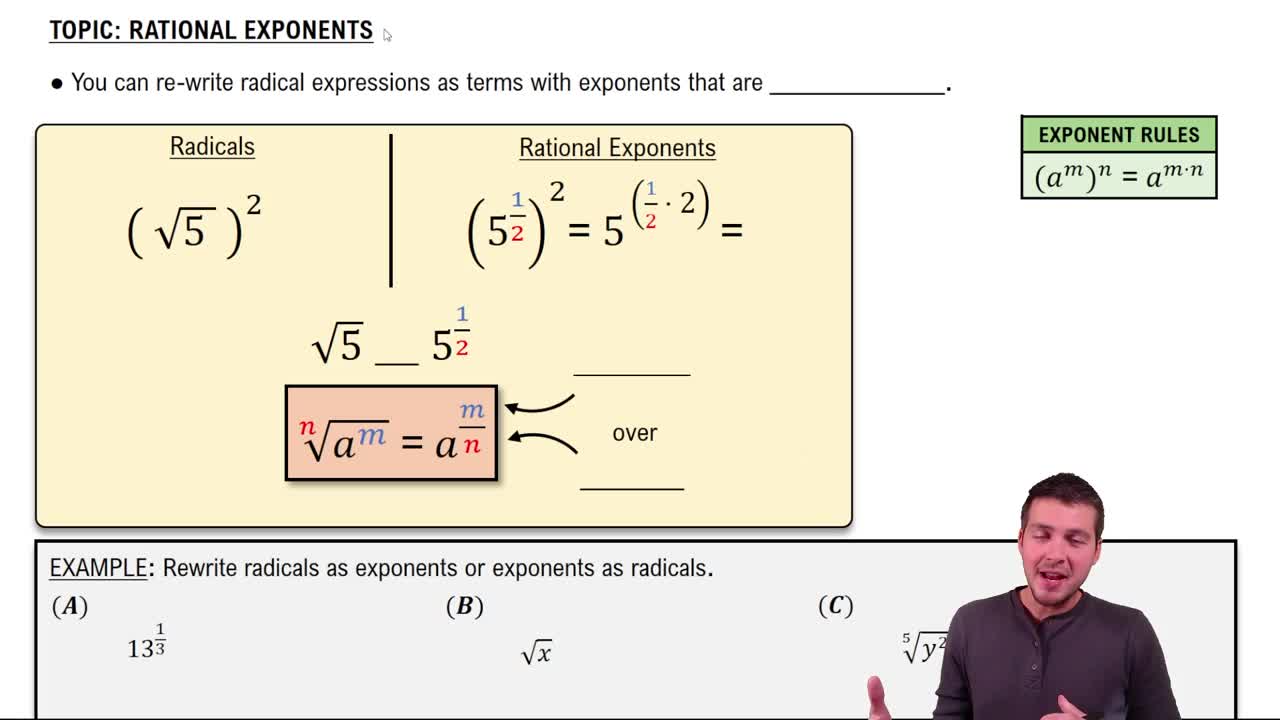Table of contents
- 0. Review of Algebra4h 16m
- 1. Equations & Inequalities3h 18m
- 2. Graphs of Equations43m
- 3. Functions2h 17m
- 4. Polynomial Functions1h 44m
- 5. Rational Functions1h 23m
- 6. Exponential & Logarithmic Functions2h 28m
- 7. Systems of Equations & Matrices4h 6m
- 8. Conic Sections2h 23m
- 9. Sequences, Series, & Induction1h 19m
- 10. Combinatorics & Probability1h 45m
4. Polynomial Functions
Zeros of Polynomial Functions
Problem 11
Textbook Question
In Exercises 9–16, a) List all possible rational zeros. b) Use synthetic division to test the possible rational zeros and find an actual zero. c) Use the quotient from part (b) to find the remaining zeros of the polynomial function. f(x)=2x^3−3x^2−11x+6
 Verified step by step guidance
Verified step by step guidance1
<b>Step 1:</b> Identify the polynomial function and its coefficients. The given polynomial is \( f(x) = 2x^3 - 3x^2 - 11x + 6 \). The coefficients are 2, -3, -11, and 6.
<b>Step 2:</b> List all possible rational zeros using the Rational Root Theorem. The possible rational zeros are the factors of the constant term (6) divided by the factors of the leading coefficient (2). This gives us the possible rational zeros: \( \pm 1, \pm 2, \pm 3, \pm 6, \pm \frac{1}{2}, \pm \frac{3}{2} \).
<b>Step 3:</b> Use synthetic division to test each possible rational zero. Start with one of the possible zeros, say 1, and perform synthetic division with the coefficients [2, -3, -11, 6].
<b>Step 4:</b> If the remainder is zero, the tested value is an actual zero of the polynomial. If not, try another possible zero. Continue this process until you find an actual zero.
<b>Step 5:</b> Once an actual zero is found, use the quotient from the synthetic division to find the remaining zeros. The quotient will be a polynomial of one degree less, which can be factored or solved using the quadratic formula if necessary.
Recommended similar problem, with video answer:
 Verified Solution
Verified SolutionThis video solution was recommended by our tutors as helpful for the problem above
Video duration:
5mPlay a video:
Was this helpful?
Key Concepts
Here are the essential concepts you must grasp in order to answer the question correctly.
Rational Root Theorem
The Rational Root Theorem provides a method for identifying all possible rational zeros of a polynomial function. It states that any rational solution, expressed as a fraction p/q, must have p as a factor of the constant term and q as a factor of the leading coefficient. For the polynomial f(x)=2x^3−3x^2−11x+6, this theorem helps in listing potential rational zeros to test.
Recommended video:
Guided course

Rational Exponents
Synthetic Division
Synthetic division is a simplified form of polynomial long division that allows for efficient division of a polynomial by a linear factor. It is particularly useful for testing potential rational zeros identified through the Rational Root Theorem. By performing synthetic division with a candidate zero, one can determine if it is indeed a root and obtain the quotient polynomial for further analysis.
Recommended video:

Higher Powers of i
Finding Remaining Zeros
Once an actual zero is found using synthetic division, the quotient polynomial can be further analyzed to find the remaining zeros. This often involves factoring the quotient or applying the quadratic formula if the quotient is a quadratic polynomial. Understanding how to derive and solve for these remaining zeros is essential for fully solving the polynomial equation.
Recommended video:

Finding Zeros & Their Multiplicity
Related Videos
Related Practice


